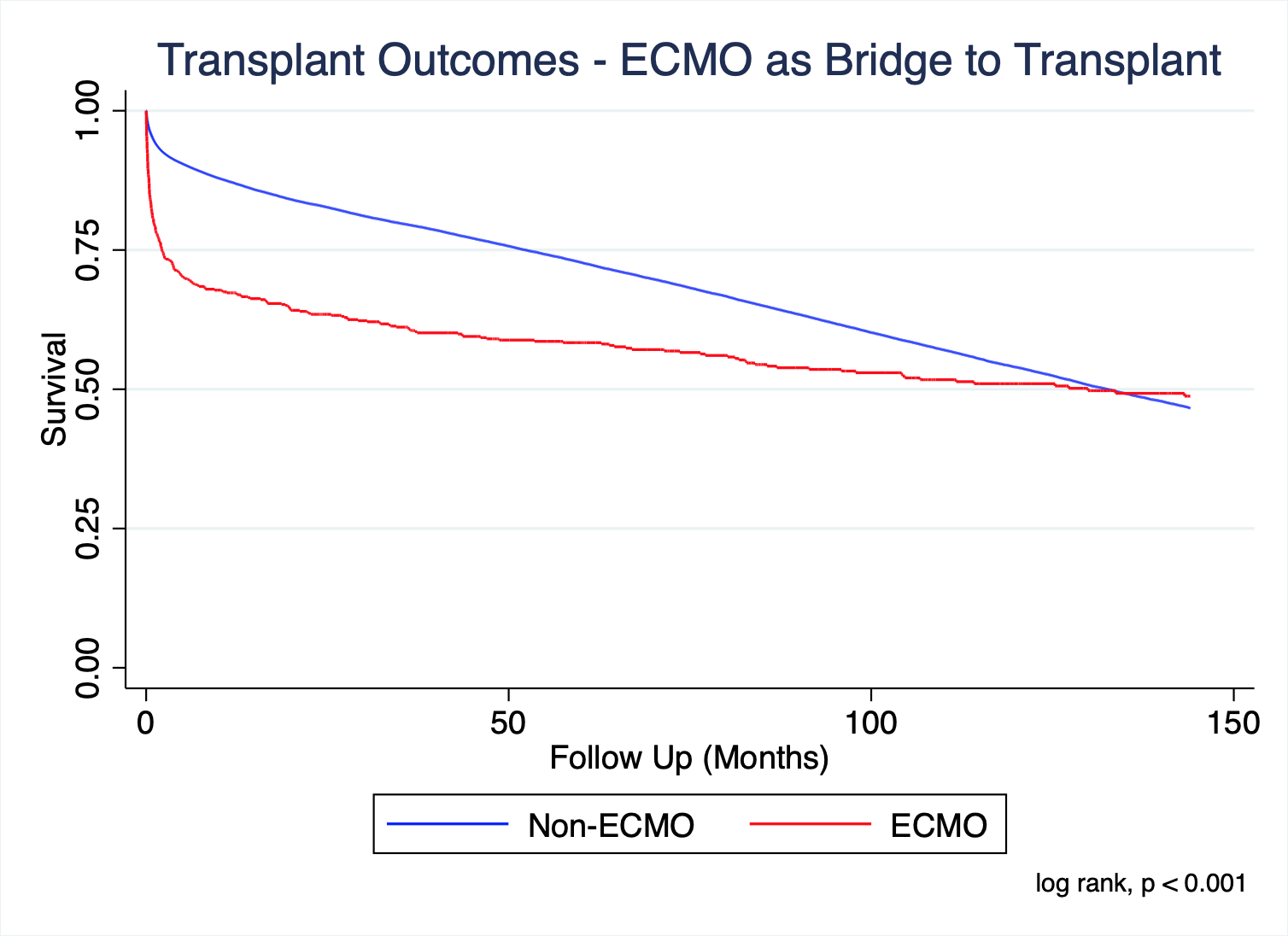Comparison of Outcomes between Patients Bridged to Heart Transplantation with ECMO versus Those Not Bridged with ECMO During the Years 1985 to 2019
1LAC-USC, Los Angeles, CA, 2UCLA Medical Center, Los Angeles, CA, 3Harbor-UCLA Medical Center, Los Angeles, CA, 4Newark Beth-Israel Medical Center, Newark, NJ, 5University of Arizona Sarver Heart Center, Tucson, AZ
Meeting: 2020 American Transplant Congress
Abstract number: 185
Keywords: Allocation, Heart transplant patients, Heart/lung transplantation, Mechnical assistance
Session Information
Session Name: Heart Transplantation: It's All About the Outcomes
Session Type: Oral Abstract Session
Date: Saturday, May 30, 2020
Session Time: 3:15pm-4:45pm
 Presentation Time: 4:27pm-4:39pm
Presentation Time: 4:27pm-4:39pm
Location: Virtual
*Purpose: Some patients with cardiogenic shock require extracorporeal membrane oxygenation (ECMO) for successful bridging to heart transplantation (HT). Herein, we report on the outcomes and differences in patient characteristics between patients bridged to HT with versus without ECMO.
*Methods: UNOS Registry data between 1985 to present were queried. A total of 1788 patients were bridged to HT with ECMO compared to 103,281 patients not bridged with ECMO. Differences in baseline characteristics between ECMO and non-ECMO patients were assessed and survival was compared using Cox proportional hazards modelling.
*Results: A majority of patients bridged with ECMO were female (40% vs 33%, p<0.001), younger (49 ± 18 years vs 35 ± 23 years, p<0.001), transplanted with younger donor hearts (28 ± 18 years vs 30 ± 14 years, p<0.001) and had overall longer ischemic times (p<0.001). Additionally, patients on ECMO had significantly shorter wait times (14 days vs 91 days, p<0.001), lower serum creatinine (0.9 ± 1.4 mg/dL vs 1.1 ± 1.0 mg/dL, p<0.001), pulmonary capillary wedge pressure (13.6 ± 8.5 mmHg vs 15.8 ± 8.7 mmHg, p<0.001) and higher cardiac output (5.0 ± 2.1 L/min vs 4.7 ± 1.6 L/min, p<0.001). Survival was significantly worse in the ECMO group with a hazard ratio of 1.72 (1.50 to 1.97). There was an early, sharp decline in survival in the ECMO group (Figure) followed by a shallower survival curve comparable to the non-ECMO group.
*Conclusions: Patients bridged to HT with ECMO were younger and more likely to be female; they were also transplanted with younger donor hearts yet had longer ischemic times and worse survival. Conditional survival of patients bridged with ECMO, versus those not bridged with ECMO, merits further investigation.
To cite this abstract in AMA style:
Miklin DJ, Salimbangon AD, Liu GS, Banankhah P, Genyk PA, Kingsford P, Chand RR, Li JP, Vucicevic D, Vaidya AS, Pandya K, Rahman J, Fong M, Grazette L, Kiankhooy A, Nattiv J, Hashmi S, Nuno S, Pizula J, Lee AE, Yang K, Shaw S, DePasquale E, Aaron WM. Comparison of Outcomes between Patients Bridged to Heart Transplantation with ECMO versus Those Not Bridged with ECMO During the Years 1985 to 2019 [abstract]. Am J Transplant. 2020; 20 (suppl 3). https://atcmeetingabstracts.com/abstract/comparison-of-outcomes-between-patients-bridged-to-heart-transplantation-with-ecmo-versus-those-not-bridged-with-ecmo-during-the-years-1985-to-2019/. Accessed December 28, 2025.« Back to 2020 American Transplant Congress

